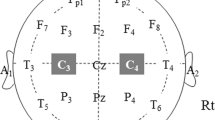Abstract
Objective
Direct cortical stimulation in commonly used for the accurate localization of the motor cortex but the electrical threshold stimulation parameters with this technique had not been fully established.
Patients and methods
A retrospective review of 15 cases of pediatric surgical cases were performed. The patients consisted of nine male patients and six female patients with age range from 2 to 18 years (mean: 10.8 years; median: 14 years). The most common pathology was cortical dysplasia (nine cases). Stimulation was performed with a train of five stimulations (range five–seven stimulations; <5% of stimulations required more than five stimulations) applied, each train of 50 μs pulse duration, with an interstimulus interval of 1.1 msec. Stimulation intensity commenced at 25 V and this was increased at 5–10 V increments until motor evoked potentials waveforms of sufficient duration and morphology were consistently generated.
Results
Monopolar electrical stimulation threshold for intraoperative motor cortical mapping were found to be more consistent in the upper limb compared to lower limb and facial muscles. Evoked responses from the extensor digitorium communis had the highest recorded rate (83.7%) and required the lowest stimulation voltage (36.0 V). The stimulation voltage was found to be statistically significant compared to threshold values for abductor hallucis, tibialis anterior, deltoid, and orbicularis oris with respective p values of 0.006, 0.021, 0,027, and 0.015. There was also a distinct trend that patients with cortical dysplasia/tuberous sclerosis have higher stimulation thresholds when compared to other pathology (p = 0.067).
Conclusion
Monopolar electrical stimulation threshold for intraoperative motor cortical mapping were more consistent in the upper limb compared to lower limb and facial muscles. Evoked responses from the extensor digitorium communis had the highest recorded rate and required the lowest stimulation voltage. There was also a distinct trend that patients with cortical dysplasia/tuberous sclerosis have higher stimulation thresholds.

Similar content being viewed by others

References
Penfield W, Boldrey E (1937) Somatic motor and sensory representation in the cerebral cortex of man as studied by electrical stimulation. Brain 60:389–443
Berger MS, Kincaid J, Ojemann GA, Lettich E (1989) Brain mapping techniques to maximize resection, safety, and seizure control in children with brain tumors. Neurosurgery 25:786–792
Duffau H, Capelle L, Sichez J, Faillot T, Abdennour L, Law Koune JD, Dadoun S, Bitar A, Arthuis F, Van Effenterre R, Fohanno D (1999) Intra-operative direct electrical stimulations of the central nervous system: the Salpetriere experience with 60 patients. Acta Neurochir (Wien) 141:1157–1167
Ebeling U, Schmid UD, Ying H, Reulen HJ (1992) Safe surgery of lesions near the motor cortex using intra-operative mapping techniques: a report on 50 patients. Acta Neurochir (Wien) 119:23–28
King RB, Schell GR (1987) Cortical localization and monitoring during cerebral operations. J Neurosurg 67:210–219
Yingling CD, Ojemann S, Dodson B, Harrington MJ, Berger MS (1999) Identification of motor pathways during tumor surgery facilitated by multichannel electromyographic recording. J Neurosurg 91:922–927
Taniguchi M, Cedzich C, Schramm J (1993) Modification of cortical stimulation for motor evoked potentials under general anesthesia: technical description. Neurosurgery 32:219–226
Szelényi A, Joksimovic B, Seifert V (2007) Intraoperative risk of seizures associated with transient direct cortical stimulation in patients with symptomatic epilepsy. J Clin Neurophysiol 24:39–43
Chitoku S, Otsubo H, Harada Y, Jay V, Rutka JT, Weiss SK, Abdoll M, Snead OC 3rd (2001) Extraoperative cortical stimulation of motor function in children. Pediatr Neurol 24:344–350
Akai T, Otsubo H, Pang EW, Rutka JT, Chitoku S, Weiss SK, Snead OC 3rd (2002) Complex central cortex in pediatric patients with malformations of cortical development. J Child Neurol 17:347–352
Author information
Authors and Affiliations
Corresponding author
Rights and permissions
About this article
Cite this article
Ng, W.H., Ochi, A., Rutka, J.T. et al. Stimulation threshold potentials of intraoperative cortical motor mapping using monopolar trains of five in pediatric epilepsy surgery. Childs Nerv Syst 26, 675–679 (2010). https://doi.org/10.1007/s00381-009-0996-2
Received:
Published:
Issue Date:
DOI: https://doi.org/10.1007/s00381-009-0996-2



